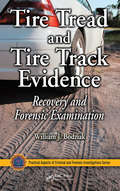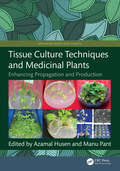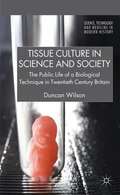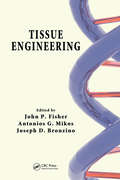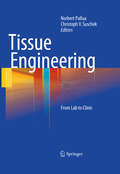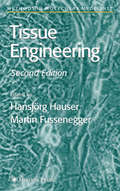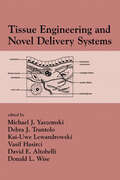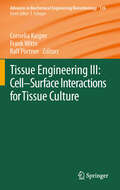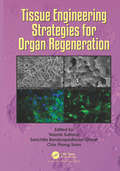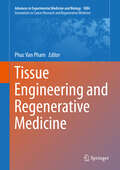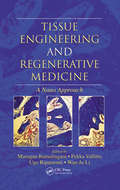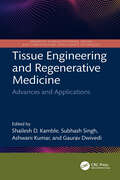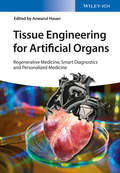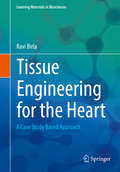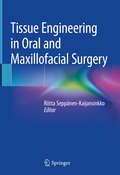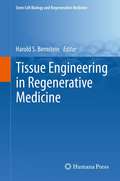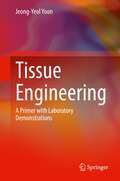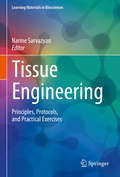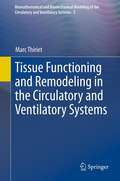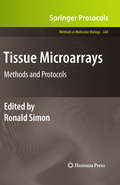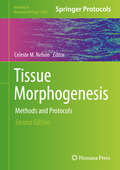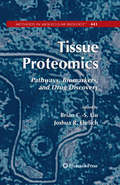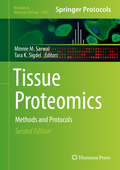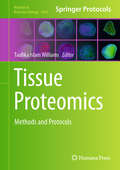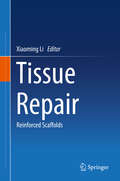- Table View
- List View
Tire Tread and Tire Track Evidence: Recovery and Forensic Examination (ISSN)
by William J. BodziakAlong with firearms, tool marks, fingerprints, and footwear, the analysis of tire marks is a key area within the forensic discipline of impression evidence. Tire Tread and Tire Track Evidence presents practical methods for recovering, examining, and interpreting this evidence within the context of actual case studies. Including basic information and terminology regarding tires, this book offers advice about the use of photographing and casting in order to recover tire evidence for examination and the proper way to examine and evaluate this evidence. Providing additional resources for further study, this text is filled with photographs to illustrate every aspect of this evidence.
Tissue Culture Techniques and Medicinal Plants: Enhancing Propagation and Production (Exploring Medicinal Plants)
by Azamal Husen Manu PantNature is the most potent source of cure and care. With the advent of the ‘herbal renaissance,’ the dependence on medicinal plants has increased in all spheres ranging from their use as raw material for medicinal, nutraceutical, cosmetic preparations, and food. The tissue culture technique has proven to be extremely advantageous not only for large-scale propagation of medicinal plants in a limited space and time, but also for conservation, storage for prolonged use, genetic improvement, and metabolite production. This book describes in detail the different methods of plant tissue culture that have been employed for the mass production of medicinal plants. The chapters on methods of organogenesis, embryogenesis, haploid plant production, virus-free medicinal plant production, and so forth will be of interest to a wide range of readers. Dedicated chapters on the tissue culture of high-altitude medicinal plants, cannabis and so on are some of the book's highlights. The book also discusses the implementation of advanced biotechnological interventions such as the production of phytochemicals, cryopreservation, nanotechnology, and bioinformatics in medicinal plant studies. With contributions from world-leading specialists in plant tissue culture, the knowledge presented in this book will aid in the translation of plant tissue culture techniques for the production and improvement of medicinal plants. The information presented has the potential to be utilized for commercial production and formulations.Key features: Comprehensive guide for tissue culture systems as potential methods for the production of clones, new varieties, improved germplasms, haploids, and in vitro preservation of medicinal plants Elaborates on standardization of in vitro systems for propagation and transplantation of important medicinal plants and enhanced secondary metabolite production Enriches the understanding of advanced technologies like cryopreservation, bioinformatics, and nanotechnology in medicinal plants tissue culture
Tissue Culture in Science and Society
by Duncan WilsonTissue Culture in Science and Society sheds new light on the biological technique known as 'tissue culture', showing how it featured regularly in British newspapers, magazines and novels, and appeared in cinema and on television throughout the twentieth century. It details how tissue culture was given meaning thanks to interplay between scientific and cultural concerns, including the modernist reappraisal of lifespan, the body and reproduction, postwar enthusiasm for 'magic bullets' and more recent discussion of patient rights. By highlighting this interaction, and charting tissue culture's history through to the present day, Wilson provides much needed context and balance for current debates.
Tissue Engineering
by Joseph D. Bronzino John P. Fisher Antonios G. MikosIncreasingly viewed as the future of medicine, the field of tissue engineering is still in its infancy. As evidenced in both the scientific and popular press, there exists considerable excitement surrounding the strategy of regenerative medicine. To achieve its highest potential, a series of technological advances must be made. Putting the numerous
Tissue Engineering
by Norbert Pallua Christoph V. SuschekTissue engineering is a multidisciplinary field incorporating the principles of biology, chemistry, engineering, and medicine to create biological substitutes of native tissues for scientific research or clinical use. Specific applications of this technology include studies of tissue development and function, investigating drug response, and tissue repair and replacement. This area is rapidly becoming one of the most promising treatment options for patients suffering from tissue failure. This abundantly illustrated and well-structured guide serves as a reference for all clinicians and researchers dealing with tissue engineering issues in their daily practice.
Tissue Engineering
by Martin M. Fussenegger Hansjörg HauserThis book provides a comprehensive volume that integrates a wide spectrum of methods required to implement current and future progress in tissue engineering. Leading experts in various disciplines provide examples of recent advances in tissue engineering-related methodologies. Authors present authoritative discussions on topics. The book supplies an understanding of diverse technologies and methods used to drive tissue engineering into a clinical reality. The knowledge contained in this volume represents the impressive progress made in the decade when tissue engineering rapidly evolved.
Tissue Engineering And Novel Delivery Systems
by Vasif Hasirci Kai-Uwe Lewandrowski Debra J. Trantolo Michael J. Yaszemski Donald L. Wise David E. AltobelliEssential to anyone working in the field, this reference focuses on latest advancements in tissue construction, repair and regeneration focusing on developments in gene and drug therapy, the evolution of tissue-engineered products, and new technologies for the design of functional tissues and organ systems.
Tissue Engineering III: Cell - Surface Interactions for Tissue Culture
by Ralf Pörtner Cornelia Kasper Frank WitteThe Cell-Surface Interaction, by J. S. Hayes, E. M. Czekanska and R. G. Richards. Studying Cell-Surface Interactions In Vitro: A Survey of Experimental Approaches and Techniques, by Stefanie Michaelis, Rudolf Robelek and Joachim Wegener. Harnessing Cell-Biomaterial Interactions for Osteochondral Tissue Regeneration, by Kyobum Kim, Diana M. Yoon, Antonios G. Mikos and F. Kurtis Kasper. Interaction of Cells with Decellularized Biological Materials, by Mathias Wilhelmi, Bettina Giere and Michael Harder. Evaluation of Biocompatibility Using In Vitro Methods: Interpretation and Limitations, by Arie Bruinink and Reto Luginbuehl. Artificial Scaffolds and Mesenchymal Stem Cells for Hard Tissues, by Margit Schulze and Edda Tobiasch. Bioactive Glass-Based Scaffolds for Bone Tissue Engineering, by Julia Will, Lutz-Christian Gerhardt and Aldo R. Boccaccini. Microenvironment Design for Stem Cell Fate Determination, by Tali Re'em and Smadar Cohen. Stem Cell Differentiation Depending on Different Surfaces, by Sonja Kress, Anne Neumann, Birgit Weyand and Cornelia Kasper. Designing the Biocompatibility of Biohybrids, by Frank Witte, Ivonne Bartsch and Elmar Willbold. Interaction of Cartilage and Ceramic Matrix, by K. Wiegandt, C. Goepfert, R. Pörtner and R. Janssen. Bioresorption and Degradation of Biomaterials, by Debarun Das, Ziyang Zhang, Thomas Winkler, Meenakshi Mour, Christina I. Günter, Michael M. Morlock, Hans-Günther Machens and Arndt F. Schilling.
Tissue Engineering Strategies for Organ Regeneration
by Naznin Sultana Sanchita Bandyopadhyay-Ghosh Chin Fhong SoonTissue Engineering Strategies for Organ Regeneration addresses the existing and future trends of tissue engineering approaches for organ/tissue regeneration or repair. This book provides a comprehensive summary of the recent improvement of biomaterials used in scaffold-based tissue engineering, and the tools and different protocols needed to design tissues and organs. The chapters in this book provide the in-depth principles for many of the supporting and enabling technologies including the applications of BioMEMS devices in tissue engineering, and the combination of organoid formation and three dimensional (3D) bioprinting. The book also highlights the advances and strategies for regeneration of three-dimensional microtissues in microcapsules, tissue reconstruction techniques, and injectable composite scaffolds for bone tissue repair and augmentation. Key Features: Addresses the current obstacles to tissue engineering applications Provides the latest improvements in the field of integrated biomaterials and fabrication techniques for scaffold-based tissue engineering Shows the influence of microenvironment towards cell-biomaterials interactions Highlights significant and recent improvements of tissue engineering applications for the artificial organ and tissue generation Describes the applications of microelectronic devices in tissue engineering Describes different current bioprinting technologies
Tissue Engineering and Regenerative Medicine (Advances in Experimental Medicine and Biology #1084)
by Phuc Van PhamThis new series, based on a bi-annual conference and its topics, represents a major contribution to the emerging science of cancer research and regenerative medicine. Each volume brings together some of the most pre-eminent scientists working on cancer biology, cancer treatment, cancer diagnosis, cancer prevention and regenerative medicine to share information on currently ongoing work which will help shape future therapies. These volumes are invaluable resources not only for already active researchers or clinicians but also for those entering these fields, plus those in industry. Tissue Engineering and Regenerative Medicine is a proceedings volume which reflects papers presented at the 3rd bi-annual Innovations in Regenerative Medicine and Cancer Research conference; taken with its companion volume Stem Cells: Biology and Engineering it provides a complete overview of the papers from that meeting of international experts.
Tissue Engineering and Regenerative Medicine: A Nano Approach
by Murugan Ramalingam Ugo Ripamonti Pekka Vallittu Wan-Ju LiThrough the integration of strategies from life science, engineering, and clinical medicine, tissue engineering and regenerative medicine hold the promise of new solutions to current health challenges. This rapidly developing field requires continual updates to the state-of-the-art knowledge in all of the aforementioned sciences. Tissue Engineering
Tissue Engineering and Regenerative Medicine: Advances and Applications (Advances in Manufacturing, Design and Computational Intelligence Techniques)
by Ashwani Kumar Subhash Singh Gaurav Dwivedi Shailesh D. KambleThe book emphasizes the technological advancements in tissue engineering related to biomaterials and biomanufacturing techniques. It further discusses important topics such as 3D bioprinting, process parameter optimization, Convolutional Neural Network (CNN) for stem cell imaging, diabetes risk prediction and Parkinson’s disease detection using machine learning, telehealth systems, acute pancreatitis, and data-driven monitoring of chronic diseases.This book: Explores the role of artificial intelligence in designing biomaterials, optimizing fabrication processes, and predicting tissue formation Focuses on technological advancements in tissue engineering related to biomanufacturing techniques, and biomaterials Discusses the denture base acrylic resins, brain tumor detection, CNN for stem cell imaging and machine learning for diabetes risk prediction and Parkinson’s disease detection. Covers acute myocardial infarction, post-operative urinary retention, telehealth systems, graph convolutional network, and acute pancreatitis. Explains the role of serum magnesium levels in febrile convulsions and Apache-II Score and Ranson Criteria with Modified CT Severity Index. It is primarily written for senior undergraduates, graduate students, and academic researchers in the fields of manufacturing engineering, biomedical engineering, materials science, biomaterials, mechanical engineering, and production engineering.
Tissue Engineering for Artificial Organs: Regenerative Medicine, Smart Diagnostics and Personalized Medicine
by Anwarul HasanA comprehensive overview of the latest achievements, trends, and the current state of the art of this important and rapidly expanding field. Clearly and logically structured, the first part of the book explores the fundamentals of tissue engineering, providing a separate chapter on each of the basic topics, including biomaterials stem cells, biosensors and bioreactors. The second part then follows a more applied approach, discussing various applications of tissue engineering, such as the replacement or repairing of skins, cartilages, livers and blood vessels, to trachea, lungs and cardiac tissues, to musculoskeletal tissue engineering used for bones and ligaments as well as pancreas, kidney and neural tissue engineering for the brain. The book concludes with a look at future technological advances. An invaluable reading for entrants to the field in biomedical engineering as well as expert researchers and developers in industry.
Tissue Engineering for the Heart
by Ravi BirlaThis book covers the fundamentals of tissue engineering for the heart, starting with the basics of organ generation, sensors in tissue and organ fabrication, and the current state-of-the-art in stem cell engineering for the heart. With this foundation in place, the remaining chapters focus on specific aspects of the cardiovascular system, starting with heart muscle, then biological pumps, followed by bioartificial ventricles, and finally, bioartificial hearts. Throughout the course of this book, twenty-two in-depth case studies are presented. Each case study has been selected to illustrate specific design schemes for tissue and organ fabrication. This is an ideal book for upper-level undergraduate and graduate students studying tissue engineering and organ regeneration, especially those focused on cardiac regeneration. This book also: Includes twenty-two case studies that illustrate specific design schemes for engineering the heart Provides open-ended discussion questions at the end of each chapter as well as a detailed reference list to encourage further research and reading Covers the basics of organ fabrication as well as sensor technology and genetic engineering as they relate to tissue and organ fabrication
Tissue Engineering in Oral and Maxillofacial Surgery
by Riitta Seppänen-KaijansinkkoThis book provides a thorough, up-to-date description of the scientific basis and concepts of tissue engineering in the oral and maxillofacial region. The opening chapters present an introduction to tissue engineering, describe the roles of biomaterials and stem cells, discuss the use of growth factors, and examine potential adverse reactions. The challenges of soft and hard tissue engineering for oral and maxillofacial reconstruction are then considered in detail. It is explained what has been achieved to date, and potential future perspectives are explored. The importance and the verification of adequate vascularization are discussed, and a further focus is the use of 3D printing, both in the planning and production of scaffolds and in the bioprinting of cells and biomaterials. Information is also included on safety, efficacy, and regulatory aspects. Tissue Engineering in Oral and Maxillofacial Surgery will be of interest to all researchers and practitioners who wish to learn more about the potential of tissue engineering to revolutionize practice in oral and maxillofacial surgery.
Tissue Engineering in Regenerative Medicine
by Harold S. BernsteinOver the past decade, significant advances in the fields of stem cell biology, bioengineering, and animal models have converged on the discipline of regenerative medicine. Significant progress has been made leading from pre-clinical studies through phase 3 clinical trials for some therapies. This volume provides a state-of-the-art report on tissue engineering toward the goals of tissue and organ restoration and regeneration. Examples from different organ systems illustrate progress with growth factors to assist in tissue remodeling; the capacity of stem cells for restoring damaged tissues; novel synthetic biomaterials to facilitate cell therapy; transplantable tissue patches that preserve three-dimensional structure; synthetic organs generated in culture; aspects of the immune response to transplanted cells and materials; and suitable animal models for non-human clinical trials. The chapters of this book are organized into six sections: Stem Cells, Biomaterials and the Extracellular Environment, Engineered Tissue, Synthetic Organs, Immune Response, and Animal Models. Each section is intended to build upon information presented in the previous chapters, and set the stage for subsequent sections. Throughout the chapters, the reader will observe a common theme of basic discovery informing clinical translation, and clinical studies in animals and humans guiding subsequent experiments at the bench.
Tissue Engineering: A Primer with Laboratory Demonstrations
by Jeong-Yeol YoonTissue Engineering: A Primer with Laboratory Demonstrations concisely covers the fundamental basics of tissue engineering. A series of simple, low-cost, and easy-to-implement laboratory modules are included in each chapter, along with experimental results with actual images and data, and a set of questions and discussion topics for each laboratory exercise. The textbook is appropriate for upper-undergraduate and graduate-level courses in cell and tissue engineering. The inclusion of images and data for all laboratory exercises also makes the book a valuable tool for scientists and engineers to learn the concepts in a hands-on and visual manner and lay a foundation to build their experiments towards their research and commercial development.
Tissue Engineering: Principles, Protocols, and Practical Exercises (Learning Materials in Biosciences)
by Narine SarvazyanTissue engineering and regenerative medicine is a new, interdisciplinary branch of science that combines knowledge from numerous scientific fields including biology, biochemistry, physics, chemistry, applied engineering, and medicine. It aims to restore damaged parts of the human body by rebuilding them in vitro using individual building blocks of biological tissues such as cells and the extracellular matrix that surrounds them. The authors hope to spark students’ interest in this exciting new field of science as well as give them a basic knowledge of its terminology.This book is based on a hands-on practical course in tissue engineering conducted by the Fulbright US Scholar recipient, Dr. Narine Sarvazyan (George Washington University, Washington USA). It provides an overview of the core topics of the tissue engineering field, including stem cell differentiation, the role of extracellular matrix and attachment proteins, scaffolds, and culturing of engineered tissues. Each chapter is accompanied by hands-on demonstrations and self-check questions. The text is easily readable for students of all backgrounds and the described protocols can be conducted using common lab equipment. This textbook is also useful for developing undergraduate and graduate courses that teach basic methods and approaches in this promising and rapidly developing field.
Tissue Functioning and Remodeling in the Circulatory and Ventilatory Systems
by Marc ThirietThe volumes in this authoritative series present a multidisciplinary approach to modeling and simulation of flows in the cardiovascular and ventilatory systems, especially multiscale modeling and coupled simulations. Volume 5 is devoted to cells, tissues, and organs of the cardiovascular and ventilatory systems with an emphasis on mechanotransduction-based regulation of flow. The blood vessel wall is a living tissue that quickly reacts to loads applied on it by the flowing blood. In any segment of a blood vessel, the endothelial and smooth muscle cells can sense unusual time variations in small-magnitude wall shear stress and large-amplitude wall stretch generated by abnormal hemodynamic stresses. These cells respond with a short-time scale (from seconds to hours) to adapt the vessel caliber. Since such adaptive cell activities can be described using mathematical models, a key objective of this volume is to identify the mesoscopic agents and nanoscopic mediators required to derive adequate mathematical models. The resulting biomathematical models and corresponding simulation software can be incorporated into platforms developed in virtual physiology for improved understanding and training.
Tissue Microarrays
by Ronald SimonToday's tissue microarray (TMA) method presents as a modern high-tech technology, one which allows for the linking of clinical data to the tissues that are combined on one slide. In Tissue Microarrays: Methods and Protocols, expert researchers explore the current world of TMA making and TMA applications, providing insight into the inherent and complex aspects of the most popular assays used for in-situ tissue analysis. Chapters examine the range of TMA techniques that allow for a large number of tissues to be included in one TMA, preserve the integrity of donor tissue blocks, and present a highly organized array pattern that allows for the reliable allocation of clinical data to individual tissue spots. Composed in the highly successful Methods in Molecular BiologyTM series format, each chapter contains a brief introduction, step-by-step methods, a list of necessary materials, and a Notes section which shares tips on troubleshooting and avoiding known pitfalls. Contemporary and ground-breaking, Tissue Microarrays: Methods and Protocols serves as an essential handbook for pathologists, molecular biologists, researchers in the life sciences, as well as physicians, a reflection of the various applications of current TMA technology.
Tissue Morphogenesis: Methods and Protocols (Methods in Molecular Biology #2805)
by Celeste M. NelsonThis second edition guides readers through experimental and computational techniques on the study of tissue morphogenesis, with a specific focus on techniques to image, manipulate, model and analyze tissue morphogenesis. Chapters focus on imagining analysis of tissue morphogenesis, culture models of tissue morphogenesis, manipulating cells and tissues in vivo, novel model systems to investigate issue morphogenesis and computational models. Written in the highly successful Methods in Molecular Biology series format, chapters include introductions to their respective topics, lists of the necessary materials and reagents, step-by-step, readily reproducible laboratory protocols, and key tips on troubleshooting and avoiding known pitfalls. Authoritative and practical, Tissue Morphogenesis: Methods and Protocols serves as a primary resource for both fundamental and practical understanding of the techniques used to uncover the basis of tissue morphogenesis.
Tissue Proteomics
by Brian Liu Joshua R. EhrlichIn one volume this book provides useful and innovative protocols developed specifically for the proteomic profiling of human tissues. The book provides high-throughput gel-based techniques, microarrays and a number of other methods used in proteomic research. This important book will prove indispensable to investigators of biomarker discovery and therapeutic response profiling, as well as those forging new paths in the fields of theranostics and personalized medicine.
Tissue Proteomics: Methods and Protocols (Methods in Molecular Biology #1788)
by Minnie M. Sarwal Tara K. SigdelThis book presents a compilation of methods that detail improved protein and peptide sample preparation and identification. Chapters guide readers through methods for depletion of myofibril-associated proteins, peptide sample preparation in urinary proteomics, purification of targeted proteins from native tissues, fractionation strategies for protein analysis, and GeLC-MS as a sample preparation method for sample preparation for proteomics using minimal amount of tissue. Written in the highly successful Methods in Molecular Biology series format, chapters include introductions to their respective topics, lists of the necessary materials and reagents, step-by-step, readily reproducible laboratory protocols, and tips on troubleshooting and avoiding known pitfalls. Authoritative and practical, Tissue Proteomics: Methods and Protocols, Second Edition aims to ensure successful results in the further study of this vital field.
Tissue Proteomics: Methods and Protocols (Methods in Molecular Biology #2884)
by Taufika Islam WilliamsThis volume details established workflows for biological interrogations to understand proteomics methods. Chapters guide readers through strategies for bottom-up tissue proteomics, proteomics landscape through different tissue types, proper decision tree for the tissue proteomics, nuanced approaches in tissue proteomics, and emerging research topics in targeted tissue proteomics. Written in the highly successful Methods in Molecular Biology series format, chapters include introductions to their respective topics, lists of the necessary materials and reagents, step-by-step, readily reproducible laboratory protocols, and tips on troubleshooting and avoiding known pitfalls. Authoritative and cutting-edge, Tissue Proteomics: Methods and Protocols aims to serve as a valuable resource to inspire new discoveries in the dynamic field of tissue proteomics.
Tissue Repair
by Xiaoming LiThis book summarizes the effective reinforcement of scaffolds by means of different kinds of fibers and tubes to meet different needs in the context of tissue repair. It covers the fabrication of the reinforced scaffolds, the factors influencing their properties, and their applications for hard and soft tissue repair. Further, it presents a range of concrete examples, case studies and research frontiers, providing readers a better understanding of how the respective fibers or tubes influence the mechanical properties, biodegradability, biocompatibility and bioactivity of scaffolds, and how they fulfill specific medical requirements. As such, the book provides a valuable and informative resource for researchers, technicians and students in the fields of biomaterials, tissue engineering and regenerative medicine.
